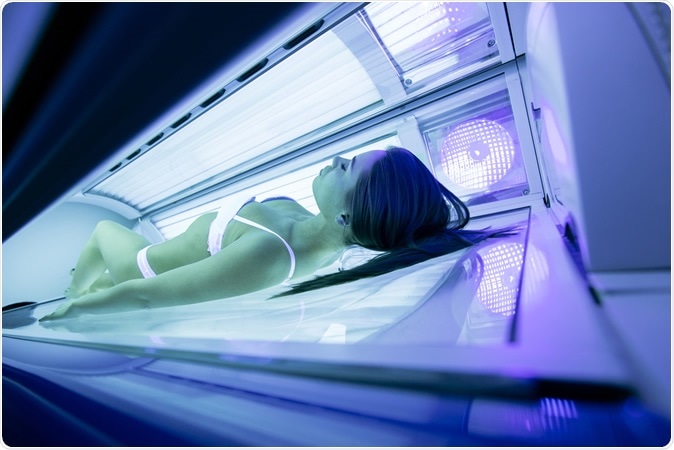A new study shows that industry-funded studies on the health impacts of indoor tanning have a greater probability of favorable results, compared to those funded by other sources. The study, published in the the British Medical Journal on February 2020, raises the possibility of biased scientific reporting which could potentially be harmful to patients and to medical science, in the long run.

Image Credit: nd3000 / Shutterstock
Ultraviolet tanning and cancer
It was only in 2009 that the World Health Organization finally concluded that the ultraviolet ray frequency used in tanning beds to produce a tanned appearance artificially was definitely a powerful cancer-producing agent. In other words, it is a group 1 carcinogen, one of a class of chemicals and exposures that carries the highest cancer risk.
However, many people are not fazed by this classification. They may cite several studies that have shown positive benefits from the use of indoor tanning, such as a better mood, increased production of vitamin D and protection of the skin against ultraviolet-induced damage by producing a base tan or darker color. In fact, the American Association of Dermatology says that over one in three adults in the USA and more than half of all college students say they have used a tanning bed at least once in their lives.
The study
The investigators analyzed over 690 articles on indoor tanning, all from scientific journals. This included not only original research but reviews of literature, opinion pieces, editorials, and case reports. The funding information and conflict of interest statements were then removed from the papers by one of the research associates before passing them on to the other researchers for analysis of the content.
The papers were rated for their support or criticism of indoor tanning on a five-point scale by researchers blinded to the source of funding. Finally, the scientists examined the level of association between industry funding and a favorable conclusion about the risk-benefit ratio of this practice.
The findings
When the scientists looked at how many were funded wholly or partly by tanning equipment manufacturers, they found that only about 10% were industry-funded research.
However, among these, almost 80% discussed the advantages of indoor tanning. The problem is, this is a gigantic discrepancy when compared to the mere 4% of non-industry-funded studies that favored indoor tanning.
In other words, industry-funded papers were much more likely to conclude that indoor tanning was safe or advantageous, and much less likely to report its dangers.
Researcher Eleni Linos says, “Studies with financial links to the indoor tanning industry were much more likely to discuss perceived benefits of indoor tanning and to downplay the harms. The association is quite striking. We need scientific data to be independent of industry influence. I am concerned that funding sources may influence the conclusions of these papers.”
Implications
We’ve been over all this before. When studies on the health impacts of smoking tobacco and of refined sugar consumption that were funded by tobacco and sugar companies, respectively, researchers consistently painted a much rosier picture of the health effects of these substances than was found to be the case with later independent research.
The bogey of paid research has still not been laid to rest; it would seem. Consequently, the onus is on the consumer to look at the statement of disclosure and find out who funded the study exploring the practice of indoor ultraviolet-based tanning. In a profit-oriented world, conflicts of interest are always almost going to end up favoring the side that pays the most money.
Co-author Meghan Halley points out the problem with misleading research paid for by the very industry whose practices are being examined: “Although the number of papers with financial ties to the tanning industry was relatively small, these papers may have wide traction if used in legal challenges and promotional material.” And secondly, she says, the label of ‘scientific journal paper’ attached to these pieces may encourage people who use indoor tanning facilities to misunderstand the level of benefit and risk they are exposed to.
This study is the first one ever to analyze the impact of financial support by the tanning industry on research literature. Linos adds, “Researchers, public health experts and members of the general public should be aware of and account for industry funding when assessing the evidence related to the risks and benefits of indoor tanning.” In other words, the reliability of research recommendations should be judged in great measure by their funding sources.